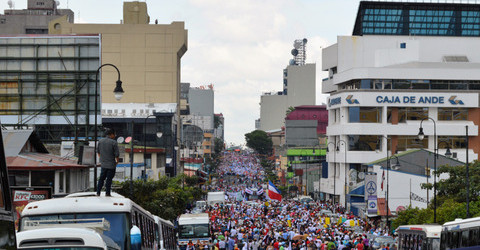
Hundreds of workers from working class neighborhoods of Caracas poured into the streets in the Venezuelan capital city late Thursday and early Friday morning, demanding food and breaking into stores. The food riots left 12 dead, including eight who were electrocuted when they became entangled in a wire while trying to break into a bakery to steal bread for their families in the El Valle district.
Demonstrations also took place overnight in the working class districts of San Martin, La Urbina, Petare, and La Candelaria. Several of the dead were reportedly shot. Government forces fired so much tear gas against demonstrators in one neighborhood that a nearby children’s hospital was evacuated.
The outbreak of food riots in working class neighborhoods in Caracas alters the already tense situation in the country of 30 million. The government blamed the opposition for the riots, while the leaders of the right wing distanced themselves from the protests. The two warring factions of the Venezuelan ruling class fear that working class discontent is on the verge of boiling over.
In recent days, the right-wing opposition has held mass demonstrations aimed at forcing the chavista government to call elections or resign. Wednesday’s demonstration provoked clashes leaving three people dead, including a police officer, a student allegedly killed by another right-wing protester, and a third opposition protester.
Unlike in previous years, the opposition demonstrations have continued and remain substantial in size, indicating that the US-backed opposition leaders are making a calculated effort to escalate the crisis instead of negotiating with the government. On Friday, the opposition held a large demonstration to commemorate Wednesday’s deaths.
The working class has abstained from the opposition demonstrations and from a smaller pro-government demonstration held Wednesday.
But the New York Times noted that opposition demonstrations are “spilling into unrest in working-class and poor neighborhoods,” and that “throughout the night, the sounds of banging pots and pans reverberated through the capital” as workers protested food shortages. AFP reported that “pitched battles” between workers and government forces lasted from nine o’clock in the evening through Friday morning.
It is as yet unclear whether the food riots are isolated incidents or whether they will develop into broader spontaneous protests, but broad hostility exists among the Venezuelan working class against both the government and the opposition.
The chavista government has enriched a section of the bourgeoisie tied to the military, the state-run oil industry and finance capital, while slashing social programs to meet interest payments to foreign creditors. The opposition is a network of corporate executives and right-wing politicians who are correctly seen by the population as stooges of US imperialism. Many workers view the opposition’s complaints over the attack on democratic rights as fraudulent.
In 1989, the opposition’s forerunner, Democratic Action (AD), massacred over 1,000 workers and youth in the Caracazo riots, which broke out over hikes to transportation costs and attacks on social conditions imposed as part of an International Monetary Fund (IMF) “adjustment” program under the administration of President Carlos Andres Perez.
The US is closely monitoring the situation under the direction of former ExxonMobil CEO and current Secretary of State Rex Tillerson. On Thursday, US State Department spokesman Mark Toner expressed concern over the decision by the Maduro government to seize a General Motors production plant in the industrial city of Valencia.
On the same day, GM workers occupied the facility in an apparent dispute over the company’s failure to pay severance benefits as promised. GM ceased production at the facility long before the government seizure but now claims the seizure was illegal.
Maduro also launched a verbal attack against the Spanish corporation Movistar on Thursday for allegedly sending millions of text and email messages calling on Venezuelans to demonstrate in Wednesday’s opposition march.
In an attempt to forestall working class opposition, the leader of the pro-government Bolivarian Socialist Central trade union announced that the union would propose a rise in the national minimum wage to help combat rising inflation rates, which reached 800 percent in 2016, according to CNBC.
The poorest 75 percent of the country—some 22 million people—lost an average 19 pounds in body weight over 2016 due to lack of food.
Eric London
You must be logged in to post a comment.